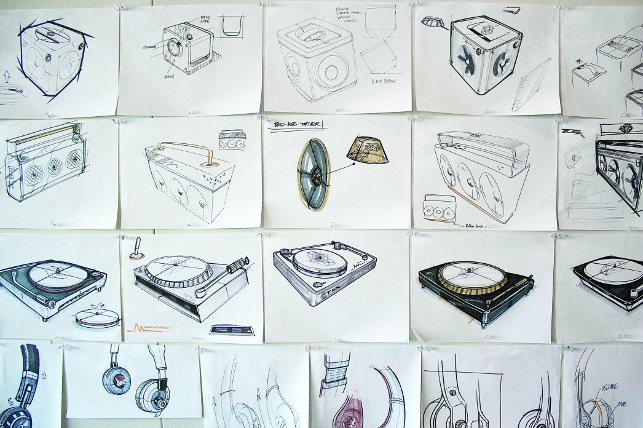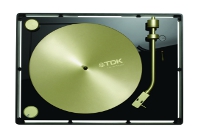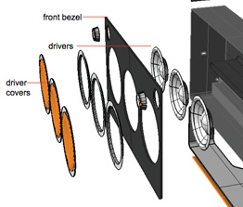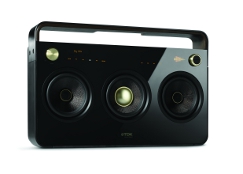Who can forget the experience of creating a mixed tape? Hours spent poring over the song selection and then carefully recording each track onto a TDK cassette.

One of Ziba’s main tools in the design process is sketching. Virtually hundreds of sketches are produced in order to explore various ideas
It was about music, listening and sharing. This has become somewhat lost in our digital world. Today we are able to access thousands of songs online and can easily download them and create playlists in minutes.
In its quest to bring back this tactile experience of listening to and sharing music TDK tasked Portland-based design agency Ziba to help it do it. The result is the recently launched TDK Life on Record range of sleek black audio products including two and three speaker Boomboxes, a 360-degree Sound Cube, two Belt-Drive Turntables and high-quality headphones.
In creating storage devices over the years – first cassettes, then CDs, DVDs and now flash drives – TDK had lost a clear consumer focus. It needed to once again connect with its users. With Imation having licensed the TDK brand five years ago, it gave the perfect opportunity to explore where the brand was going and the possibility of developing new products.
“The situation we were in was that we not only needed an industrial design group but also a partner who could help us define a strategy for the brand both short term on a new product line and long term taking the brand forward,” explains Tren Blankenship, global marketing manager at TDK Life on Record.
Brief encounter
So, having decided that Ziba was the agency that would help them do this, they approached them with a pretty open-ended brief. Together they sat down and brainstormed hundreds of different ideas and produced countless sketches across a range of categories from storage, audio and gaming products all the way through to peripherals for PCs.
The teams quickly agreed that the focus had to be on audio products. “We proposed to TDK that we do a design language program that defines a handful of products. This would involve developing rules and beliefs about the brand and its consumer and then outputting some reference products that would demonstrate what that looks like,” says Paul O’Connor, a creative director at Ziba.
Ziba asserts that it differentiates itself from other design agencies by really focussing on in-depth qualitative user research at the front end of the design process. By being consumer focussed it believes that it can create products and brands that are better connected to the target consumer.
In this case, by utilising one of its main design tools – brainstorming – the designers soon realised that these products really had to be about the experience of listening to music more than the tech spec.
They drew inspiration from TDK’s heyday of the cassette tape and how it enabled consumers to meaningfully engage with music. “There was an emotional attachment that people had when making mixed tapes and we wanted to create audio products that had this same emotional connection, to really give people a hands on experience with the music again,” says Blankenship.
Paul Backett, Ziba’s industrial design director, explains that in TDK’s quest to create newer versions of storage devices, they hadn’t really recognised the essence of what they did. “This essence wasn’t in storage but in the real value of creation and sharing,” he comments. “We wanted to bring this essence and meaning behind the brand back and make products that would connect with people on these levels.”
Face the music
As part of its research into gaining a deeper understanding of the experience of music and different music cultures, the Ziba design together with the TDK brand team jetted off to five different music loving cities: Tokyo, San Francisco, Manchester, Sydney and Berlin.
After three months of investigation they honed down on who their target consumer was going to be – the Music Prophet. These were young men in their 20s and 30s that weren’t necessarily musicians but had a great passion for music. They would dedicate hours to listening to their huge music collections.
From talking to them the designers soon discovered that despite digital music being virtually on tap, they felt a sense of detachment from it. They felt nostalgic for the listening experience that analogue music gave them – the social nature of records and cassettes, the crackle of vinyl and tactile feedback of their music players.
Loud and clear
So, the question was: what does the Music Prophet need from TDK?
The answer lay in products that would give them a better experience of listening to music. This meant combining the best of the analogue experience with the convenience and style of new digital technology.
They called this ‘Digi-Log’: bringing the warmth of analogue to digital listening. Making this their primary design guideline, they set about creating a line of audio products that would allow listeners to see and touch the music as much as possible.
Although initially sceptical, creating a boombox seemed obvious. It after all was the ultimate out-loud listening experience of the 1980s. Also called ghetto blasters, these iconic products epitomised the sharing of music and helped shape popular culture.
“If you put a boombox down in the park or on a street corner you were making a statement. They were considered to be offensive and we were really intrigued by the cultural origins and relationship of the birth of hip hop and what that meant to people,” says O’Connor.
But O’Connor also realised that in order to do the boombox justice the design team needed to play cultural historians. It seemed that today they had just become sad caricatures of themselves more likely to be featured on a t-shirt or fashioned into a handbag. He felt that without gaining a true respect for where boomboxes came from and knowing why they went away, the designers would not be able to capture their essence.
The three speaker Boombox with its retro look features a high excursion 6 -inch subwoofer driver and two 6-inch coaxial drivers
The boombox design process really kicked off with the question of how big it could be. One of the first things the designers did was cut a giant block of white foam using its in-house hot wire foam cutter.
Although, the size could be considered absurd, they were trying to embody that boombox attitude of not being afraid to go big. “It was strange because normally you would play around with the product’s size for weeks but this was so spot on,” says O’Connor.
“We knew it was causing some disturbances in the force because it engaged people in conversation about whether it was too big or not. In some projects we’d react to this by altering the product’s size to one everyone was happy with. But in this case we wanted to keep it at this size that polarised people because we are asking them to commit to taking a stance on it,” he adds.
So, by making a quick foam model in this instance proved to be very beneficial. In fact, Ziba strongly believe in the power of model making. For them it’s crucial to be able to quickly fashion something with your hands instead of just jumping straight into 3D. “If you know how to make 3D foam models using your hands then you’ll understand how to model things on the computer in 3D.
I think it’s terrible that many of today’s students think they can just make something in 3D software; 3D software isn’t going to make it for them,” argues Christian Freissler, a senior industrial designer at Ziba.
Ziba – Box clever
So, having lived with the large rectangular foam model of the boombox in the design studio for a while it led them to the creation of a 10-inch x 10-inch sound cube. “We thought why not create a boombox that has speakers on all four sides,” says O’Connor.
This may sound like they were going off on a tangent running away with their ideas. But the designers purposefully didn’t get the engineers involved as they really wanted to defi ne the products and create a design language before bringing in someone who would tell them that technically it couldn’t be achieved.
“So we suspended disbelief for a little while by letting that vision carry on and take route otherwise there are always plenty of people around to kill ideas, there is no shortage of those people,” says O’Connor.
“As we got further and further into the process and the products became more finalised, we started to bring in audio and acoustic engineers on our side to make sure that what we were designing could actually be made and done at a realistic price for us,” adds Blankenship.
The team at TDK were very much involved in the design process and shared Ziba’s vision for the products. “What we saw was that a lot of the products especially around Apple devices had become very generic. We agreed with Ziba’s recommendation and philosophy that we really needed to change that market space,” says Blankenship.
Ziba’s interaction designers worked alongside the industrial designers on the interface, looking at how the users could simply and intuitively interact with the products. Many prototypes were developed until they achieved an interface for each of the products epitomised the notion of Digi-Log.
For instance, on the boombox an LED display was placed next to chunky controls and touch-sensitive buttons, giving precise control and tactile feedback. They also devised the signature graphic element of the music visualiser that would be used across all the products. This ‘visual heartbeat’ pulsed when the music played, providing a connection to the music.
Ziba – Colour me pretty
Ziba also created many theme boards exploring the different colours and finishes that would help establish a unique design language. The materials needed to portray craftsmanship and precession and so they looked at leather, aluminium and acrylic materials.
The end result are different tones of black contrasted with the glossy acrylic and champagne-coloured knobs and details. Its a design that echoes the iconic black and charcoal TDK cassette tape with its copper pin stripe.
So, having created a design language for each of the four products they then refi ned them more or less in parallel. As O’Connor says, Ziba were most clearly responsible for design intent not the details of the execution so in this project, their CAD files went as far as the surfaces. The main tools used in the process included Autodesk Sketchbook Designer for digital sketching and Rhino for CAD. “Ziba has a long history with Rhino.
The ST800 headphones is not only comfortable but looks pretty slick with its metallic detailing and genuine leather accents
It’s a cheap but really good tool. It’s not parametric so we sometimes have to start over with things but then at the same time, it’s quick and easy,” comments Freissler.
From these CAD files they created cosmetic models, which were then taken by representatives from each of the Ziba and TDK teams to the Chinese manufacturer. This helped to ensure that the vision was held.
“The beauty was that as a cosmetic model existed it gave our client something to fight for. It’s just a real tangible way of understanding when compromises happen, what it means,” explains O’Connor. “As the Ziba crew and the client crew were united, we stood in the face of the manufacturing team and fought for what we wanted.”
From Blankenship’s point of view, they worked very closely with the manufacturer to make sure things were done right. One manufacturer produced the turntable whilst another produced the remaining three products.
Having a single company manufacture the bulk of the product line made it a great deal easier for TDK. “They understand the quality that we are looking for and because the products are fairly similar, there are a lot of components that we can use across the line,” he says.
Go on record
Following their vision for the products to China proved to be worthwhile because, according to O’Connor, the cosmetic models and final products are virtually identical. Having showcased the TDK Life on Record products at a handful of exhibitions, they were officially launched in February.
According to Blankenship, the reception to them has been amazing both from reviewers and the public. “We had the freedom to really redefine the brand and I think we did that very successfully,” says
Blankenship. “The audio line turned out pretty amazing, we are extremely happy with them.”
Who knew that listening out loud to music could look this good?
www.tdkperformance.com
www.ziba.com

An analogue icon goes digital with the TDK Life on Record range










